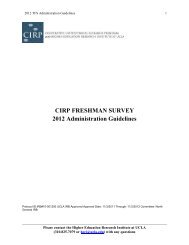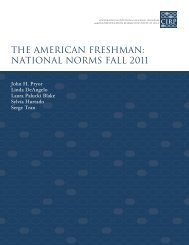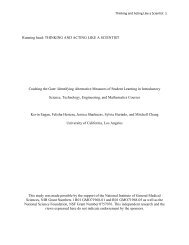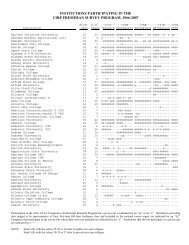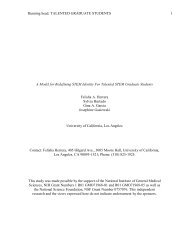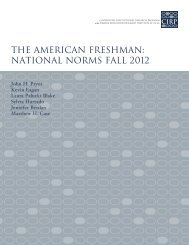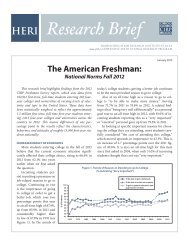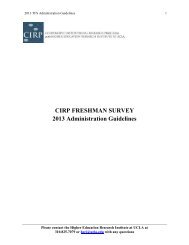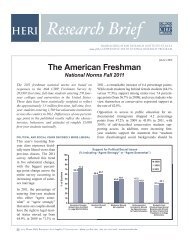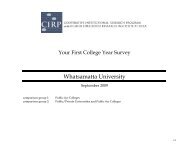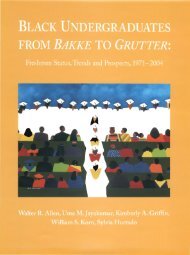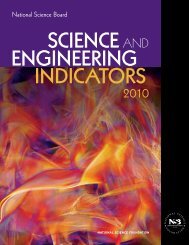North Dakota University System - Higher Education Research Institute
North Dakota University System - Higher Education Research Institute
North Dakota University System - Higher Education Research Institute
You also want an ePaper? Increase the reach of your titles
YUMPU automatically turns print PDFs into web optimized ePapers that Google loves.
HERI 1998-99 Faculty Survey<br />
Analysis of Results for the <strong>North</strong> <strong>Dakota</strong> <strong>University</strong> <strong>System</strong><br />
Summary<br />
Purpose: To provide data on the faculty members from the doctorate-granting, four-year,<br />
and two-year institutions within the state of <strong>North</strong> <strong>Dakota</strong>.<br />
Broad <strong>Research</strong> Questions: What are the general characteristics of faculty in <strong>North</strong><br />
<strong>Dakota</strong>’s eleven public institutions of higher education? Do faculty differ by type of<br />
institution? How do <strong>North</strong> <strong>Dakota</strong> faculty compare to faculty in similar institutions<br />
across the United States?<br />
Methodology: Faculty from <strong>North</strong> <strong>Dakota</strong>’s eleven public institutions participated in the<br />
national survey of college and university faculty conducted by the <strong>Higher</strong> <strong>Education</strong><br />
<strong>Research</strong> <strong>Institute</strong> (HERI) in the fall and winter of 1998-1999. Of 1,563 questionnaires<br />
mailed out to NDUS faculty, usable returns were eventually received from 930 for a total<br />
response rate of 59.5 percent.<br />
Findings:<br />
• <strong>North</strong> <strong>Dakota</strong>’s doctorate-granting institutions had the highest percentages of<br />
male faculty and the lowest percentages of female faculty than four-year, twoyear<br />
and national institutions.<br />
• The majority of <strong>North</strong> <strong>Dakota</strong> faculty held the rank of associate professor.<br />
• Two-year institutions reported higher percentages of tenured status than doctorate,<br />
four-year, and national institutions. NDUS doctorate institutions recorded the<br />
lowest percentages for tenured status.<br />
• <strong>North</strong> <strong>Dakota</strong> faculty at two-year institutions were generally younger than their<br />
peers at four-year and doctorate institutions, ranging from 35 to 44 years of age.<br />
• The primary interest and principal activity of faculty in <strong>North</strong> <strong>Dakota</strong>’s eleven<br />
public institutions was teaching, and their highest goal was to be good teachers.<br />
• <strong>North</strong> <strong>Dakota</strong> faculty spent significantly more time in the classroom and on<br />
teaching-related activities than did their peer nationally. Faculty in the five twoyear<br />
institutions expended the most time.<br />
• <strong>North</strong> <strong>Dakota</strong> faculty spent significantly less time on research than do their peers<br />
nationwide, particularly in the doctorate-granting institutions. Thus, <strong>North</strong><br />
<strong>Dakota</strong> faculty published less than faculty nationally.<br />
• The average <strong>North</strong> <strong>Dakota</strong> faculty member spent over 50 hours per week on jobrelated<br />
activities (cf. 51.6 hours per week for doctorate institutions, 53.2 hours for<br />
four-year, and 54.0 hours for two-year).<br />
• <strong>North</strong> <strong>Dakota</strong> were generally using information technology more than their peers<br />
nationally, specifically for communicating by e-mail.<br />
• <strong>North</strong> <strong>Dakota</strong> faculty were, overall, less satisfied with their jobs than faculty<br />
nationally, particularly in the area of salary and benefits.<br />
1



